复合相变储能保温砂浆在日光温室中的应用效果
周 莹,王双喜
复合相变储能保温砂浆在日光温室中的应用效果
周 莹1,2,王双喜1※
(1. 山西农业大学工学院,太谷 030801; 2. 菏泽学院城市建设学院,菏泽 274000)
为改善日光温室内作物生长的热环境,该文研制了一种适用于日光温室的石膏基石蜡/膨胀珍珠岩复合相变储能保温砂浆,其相变温度为25.6 ℃,相变潜热为89.8 kJ/kg。并将50 mm的复合相变保温砂浆用于砖墙日光温室的后墙作为试验温室,与无相变材料的原砖墙温室(即对照温室)进行对比试验。在试验周期内,试验温室的室内日最低温度比对照温室平均高出1.5 ℃,最高可达2.4 ℃;其中,阴天试验温室的室内温度比对照温室平均高1.6 ℃;晴天试验温室的室内最高温度比对照温室低1.7 ℃,室内最大温差比对照温室低3.1 ℃,夜间(17:00-次日8:00)试验温室室温比对照温室平均高2.7 ℃;多云期间,试验温室的室内最高温比对照温室低1.4 ℃,最大温差比对照温室低3.5 ℃,夜间试验温室室温比对照温室平均高2.3 ℃;在相同栽培管理条件下,生长旺盛期和坐果期,试验温室的黄瓜植株高度比对照温室分别平均高出17.1和24.6 cm,试验温室内黄瓜的单果质量和单株结果数分别为对照温室的1.4倍和1.3倍,单株产量为对照温室的1.8倍。试验结果表明,复合相变储能保温砂浆具有良好的保温和蓄、放热效果,对日光温室内的热环境具有明显的改善效果,使其更适于黄瓜的生长。
相变材料;温度;保温;保温砂浆;日光温室;热环境
0 引 言
日光温室墙体作为温室吸收和储存太阳能并为温室增温的载体,对提高室内作物生长热环境控制能力至关重要[1],其白天蓄集太阳能的能力越强,夜间提供给温室内的热量也越多[2-3],整个墙体的隔热保温及蓄热能力的强弱决定着室内作物能否安全越过北方寒冷的冬季[4],如果温室墙体的保温蓄热性能差,则会导致室内气温较低,使作物遭受冻害,影响产量[5-6]。随着相变蓄热技术与材料的发展和进步,相变蓄热储能材料逐渐应用于日光温室墙体中。将相变材料应用在温室中,可以在白天温度高的时候吸收温室多余的热量,而在夜间温度低的时候将其释放出来,对室内温度起到“削峰填谷”的作用[7]。陈超等[8-18]对中国日光温室应用相变材料做了深入研究,将所研制的相变材料用于温室后墙,提高了墙体的蓄热能力,温室生产取得了明显的效果。在众多中、低温相变材料中,石蜡因具有相变潜热较高、几乎没有过冷相象、没有相分离和腐蚀性等优点而成为常用蓄热材料[19]。石蜡在使用过程中,由于固—液相变作用,易出现渗漏、溢出现象,为了克服石蜡易渗漏等缺点,通常将石蜡与其他材料复合制备复合相变储能材料。李启金等[20]研究表明,多孔膨胀珍珠岩对石蜡良好的吸附性,膨胀珍珠岩的毛细作用和表面张力能有效解决石蜡在储热应用时的液态流动问题,提高石蜡的稳定性。Bascetincelik等[21]将相变储能石蜡应用于温室生产,取得了一定的加温效果。王蕊等[22]利用石蜡为相变材料,制备了玻化微珠相变蓄热材料,并进行日光温室模拟试验,达到了节能和环保双重目标。王朋等[23]研制出了石蜡、硬脂酸正丁酯复合相变材料应用于温室中,蓄放热效果明显。周玮[24]以石蜡、石墨、高密度聚乙烯等为主要成分制备了复合定形相变材料,并制成了复合相变蓄热墙体材料,应用于日光温室后墙,提高了温室内空气温度和太阳能利用率。
将相变储能材料用于温室生产,可大大提高温室室内气温和地温,同时可减薄温室墙体,提高土地利用率,基于以上原因本文依据建筑储能保温砂浆的原理[25],以石蜡为相变材料,选取价格低廉、性质稳定的轻质多孔膨胀珍珠岩为其载体材料,以成份稳定、低容重、低收缩的建筑脱硫石膏为胶凝材料,研制了一种适用于温室生产的新型石膏基石蜡/膨胀珍珠岩复合相变储能保温砂浆,并用其作为砌块墙日光温室后墙的内保温砂浆,以期改善日光温室内的热环境和作物生长环境,为日光温室更好的越冬生产提供科学参考。
1 材料与方法
1.1 试验材料
1.1.1 试验原材料
25#相变石蜡,河南南阳石蜡精细化工厂,熔点24.9 ℃,相变潜热186 kJ/kg;多孔膨胀珍珠岩,河南范县光正保温材料有限公司,粒径0.5~1.5 mm;建筑脱硫石膏,山东泰安宏利石膏加工有限公司;可再分散乳胶粉、聚丙烯纤维、外加剂等。
1.1.2 试验材料的制备
25#相变石蜡与多孔介质膨胀珍珠岩按质量比6∶4进行真空吸附,制备得到石蜡/膨胀珍珠岩复合定形相变颗粒。将复合定形相变颗粒与脱硫石膏、可再分散乳胶粉、外加剂等材料按比例配制石膏基石蜡/膨胀珍珠岩复合相变储能干粉砂浆,按照水灰比=0.8加水混合搅拌后直接用于墙体施工。复合相变储能保温砂浆基本配比如表1所示,生产工艺流程见图1。

表1 复合相变储能保温砂浆配方

图1 复合相变储能保温砂浆制备流程
1.2 试验温室
试验温室位于山东省菏泽市阡陌农耕现代农业园(35°14′N,115°22′E),温室长20 m,跨度8 m,脊高3.5 m,后墙高2.5 m,后墙为500 mm厚(120 mm砖+140 mm空气间层+240 mm砖)砖墙,东西山墙为240 mm厚砖墙,室内下挖500 mm;温室前屋面为全钢桁架结构,后屋面由聚苯板和防水材料组成,前屋面采用双层PC板为透明覆盖材料,卷帘机—保温被机构进行外保温。为便于试验,将温室沿长度方向从中间位置隔开,分成2个温室区域,其中西侧温室区域后墙不变(对照温室),东侧温室区域内依据ANSYS有限元分析软件模拟,以复合相变储能保温砂浆厚度为50 mm对后墙内侧进行涂抹处理(试验温室),温室平面图及试验温室剖面图如图2所示。

a. 温室平面图及测点布置
a. Plan of greenhouse and layout of measuring points
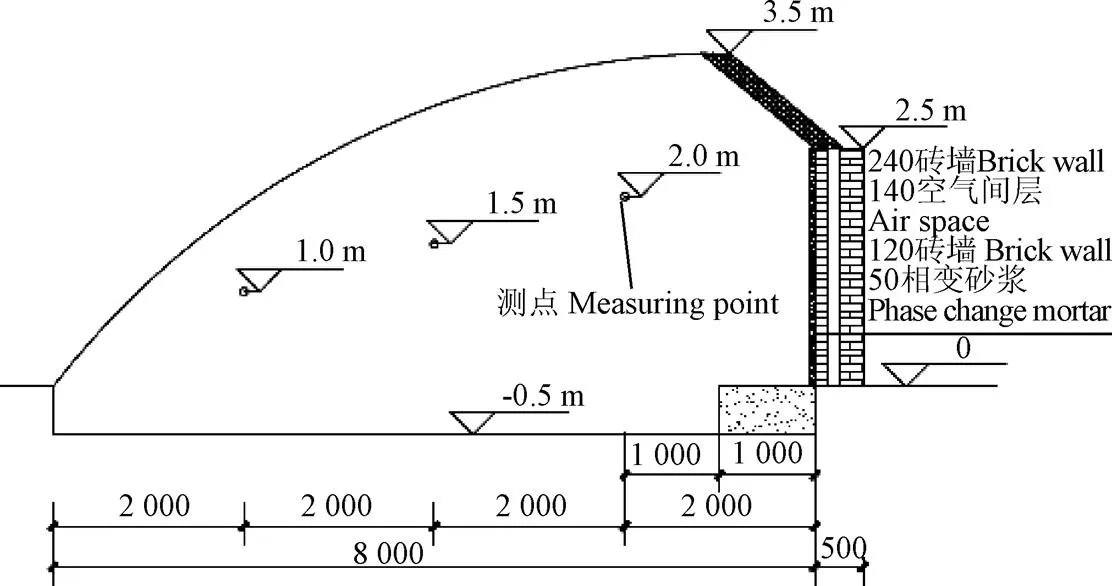
b. 试验温室剖面图及测点布置
1.3 试验仪器设备
DYB-2000型电液式压力试验机,献县亚星公路建筑仪器厂;STA 449 F3同步TG-DSC热分析仪,德国耐驰公司;PDR导热系数测定仪,济南赛文特仪器设备有限公司;NL-5小型农业气象站,温度范围:−40~120 ℃(精度±0.4 ℃,分辨率0.1 ℃),湿度范围:0~100% RH(精度±3% RH,分辨率0.1% RH),光照强度范围:0~200 000 lx(分辨率1 lx),风速范围:0~45 m/s(精度±(0.3+0.015)m/s),浙江托普仪器有限公司;多通道温湿度测试仪,温度范围:−50~150 ℃(精度±0.5 ℃,分辨率0.1 ℃),湿度范围:0~100% RH(精度±3% RH,分辨率0.1% RH),杭州联测自动化技术有限公司;精密电子天平、烧杯、卷尺、游标卡尺等。
1.4 试验方法
1.4.1 试验材料性能的测定
复合相变储能保温砂浆抗压强度的测试采用电液式压力试验机,依据《JGJ/T 70-2009 建筑砂浆基本性能试验方法标准》[26]进行。
复合相变储能保温砂浆相变温度和相变潜热的测试采用TG-DSC热分析仪进行,并根据试验数据绘制DSC曲线图,吸热峰值为相变温度,曲线围合面积积分得到相变潜热[27]。
复合相变储能保温砂浆导热系数的测定采用导热系数测定仪,按照《GB/T 10294-2008绝热材料稳态热阻及有关特性的测定》[28]进行。
1.4.2 温室内外温度环境及黄瓜生长状况监测
NL-5小型农业气象站用于监测温室外环境,设置测定时间间隔为10 min。
多通道温湿度测试仪用于监测温室内热环境,试验温室和对照温室室内分别设置6个温湿度测试点,其中1列3个测点分别距地面1.0、1.5、2.0 m,距后墙6.0、4.0、2.0 m,距温室东(西)墙3.0 m布置,另1列3个测点距地面1.0、1.5、2.0 m,距后墙6.0、4.0、2.0 m,距温室隔墙3.0 m布置,设置测定时间间隔为10 min,测点布置如图2a、2b所示。
两温室内定植相同龄期的“鲁蔬21号”黄瓜幼苗(耐低温,耐弱光),高畦栽培,每温室5行,每行10株。定植后,在两温室中各选取栽培位置相同、长势一致的10株植株(每行取2株)作为测定对象,根据植株不同生育期进行跟踪形态指标测定。用精度为1 mm的卷尺测量各温室中10株黄瓜的株高(地面至生长点),取平均值;用精度为0.1 mm的游标卡尺,测量各温室中10株黄瓜子叶基部平行于子叶方向的植株直径为茎粗[29],取平均值;统计各温室内10株黄瓜的总产量,并求平均单株产量。
试验周期内,试验温室与对照温室的水肥、通风、补光、遮盖保温被等栽培管理方式完全一致。
2 结果与分析
2.1 复合相变储能保温砂浆的性能
利用TG-DSC热分析仪测得复合相变储能保温砂浆的DSC曲线如图3所示,得到复合相变储能保温砂浆的相变温度为25.6 ℃;相变潜热为89.8 kJ/kg,符合王宏丽等[30]提出的相变储能材料在满足相应的蓄放热性能外,还应满足植物生长所需条件,经测定复合相变储能砂浆的基本性能参数如表2所示。
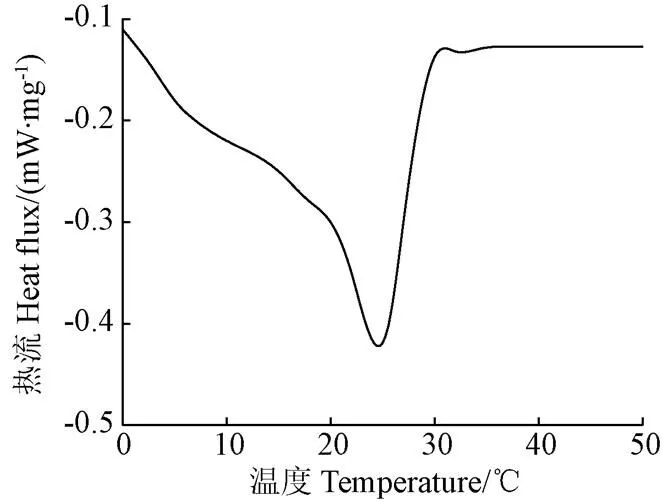
图3 复合相变储能保温砂浆DSC曲线

表2 复合相变储能保温砂浆的性能参数
2.2 温室内外热环境及黄瓜生长状况
黄瓜幼苗于2015年11月20日定植,2016年2月20日对测试株成熟黄瓜进行采收,测定果实产量。对整个测试其内试验温室和对照温室的室内日最低温度变化情况进行对比分析,根据实测气象数据,选取2016年1月31日08:00-2月1日08:00(阴)、2016年2月2日08:00-2月3日08:00(晴)和2016年2月3日08:00-2月4日08:00(多云)所测得的对比数据进行热环境分析研究。
2.2.1 冬季温室室内日最低气温变化
试验周期(2015年12月10日-2016年02月18日)内,试验温室和对照温室的室内日最低温度变化情况如图4所示。
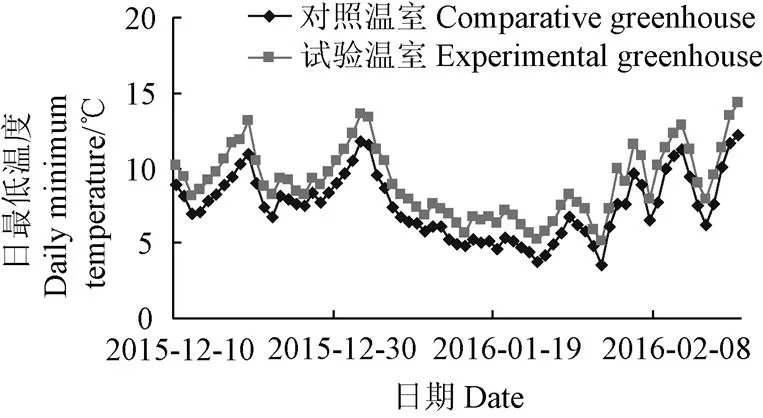
图4 2015-12-10—2016-02-18室内日最低气温
由图4可知,在试验周期内,对照温室室内日最低温度中出现低于5 ℃的情况,其中最低为3.5 ℃,平均日最低温度为7.8 ℃;试验温室室内日最低温度均大于5 ℃,其中最低为5.2 ℃,平均日最低温度为9.3 ℃;试验温室室内的日最低温度比对照温室的平均高1.5 ℃,最高可达2.4 ℃。试验温室和对照温室室内的日最低温度的变化趋势基本一致,且试验温室室内的日最低温度均高于对照温室的日最低温度,说明试验温室应用的相变储能保温砂浆具有良好的相变蓄热、放热性能,温室内最低温度的提高,将有效防止作物受到短时冷害、冻害的影响,有利于作物的生长发育。
2.2.2 阴天温室内外热环境变化
2016年1月31日阴天,保温被全天处于遮闭状态,温室内外温度变化如图5所示。
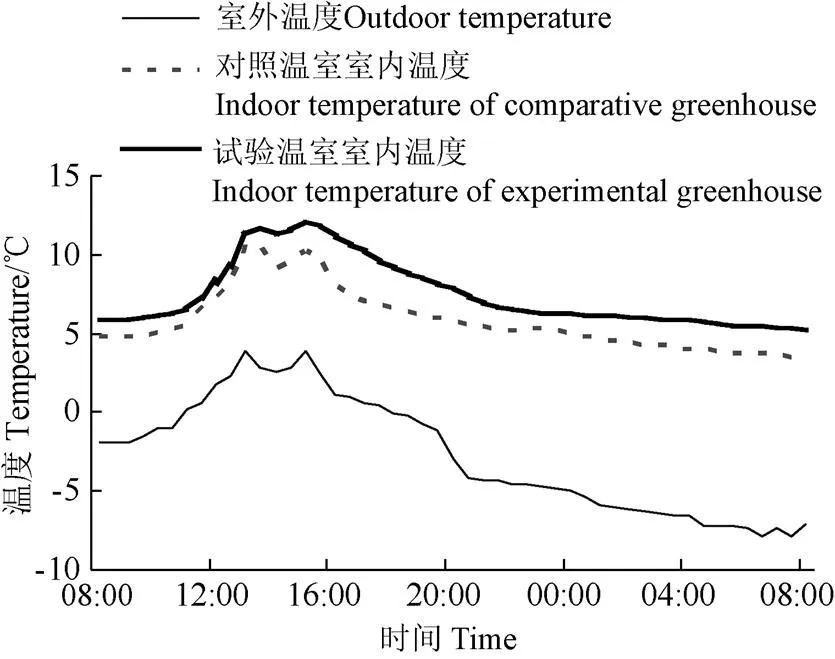
图5 阴天室内外温度
由于阴天室外温度较低,保温被处于遮闭状态,受室外环境影响,两温室室内温度均较低。对照温室的室内最低温度为3.5 ℃,试验温室的室内最低温度为5.3 ℃,比对照温室的高1.8 ℃;对照温室和试验温室室内最高温分别为10.7和12.1 ℃;试验温室全天的室内温度始终高于对照温室,平均高1.6 ℃,说明在没有外来热源的情况下,试验温室的保温效果优于对照温室,相变储能保温砂浆的保温效果明显。
2.2.3 晴天温室内外热环境变化
2016年2月2日晴天,08:30开启保温被,17:00遮闭保温被,室内外温度变化如图6所示。

图6 晴天室内外温度
晴天,上午08:30保温被开启后,受室外太阳辐射和围护结构的影响,温室内温度快速上升,期间,为确保植物正常生产,进行了同步适当通风。08:00-13:00期间,试验温室的室内温度比对照温室高0.5~1.8 ℃;在室内外温度相对较高的13:00-15:00期间,试验温室比对照温室室温低0.6~1.8 ℃,平均低1.3 ℃,且在14:00左右出现一天中的最高室温时,试验温室最高室温为28.9 ℃,比对照温室的最高室温30.6 ℃低1.7 ℃,相变材料的蓄热降温效果明显;15:00以后,随着太阳辐射和室外气温的下降,两温室室内温度均下降,试验温室的降温速率低于对照温室,相变储能砂浆的保温效果凸显,至17:00保温被遮闭时,对照温室和试验温室的室内温度分别为20.3和24.2 ℃;17:00至次日08:00保温被关闭期间,试验温室内最低气温为10.0 ℃,对照温室内最低气温为7.7 ℃,试验温室的室内温度始终高于对照温室,平均高2.7 ℃,相变材料的放热保温效果明显;全天,试验温室室内最大温差为21.3 ℃,对照温室室内最大温差为24.4 ℃,相变储能保温砂浆明显缩小了室内峰谷温差。
2.2.4 多云温室内外热环境变化
2016年2月3日多云,早08:30开启保温被,17:00遮闭保温被,温室内外温度变化如图7所示。
由于多云,全天没有进行温室通风。08:00-12:00期间,试验温室室内温度比对照温室高1.0~2.5 ℃,平均高2.1 ℃;12:00-15:00期间,试验温室室内最高温度为30.2 ℃,对照温室室内最高温度为31.6 ℃,试验温室室内温度比对照温室低0.4~1.8 ℃,平均低1.2 ℃,说明当温室内温度高于复合相变砂浆的相变温度时,复合相变储能砂浆处于吸热蓄热状态,促使试验内温室升温变缓,相当于一定的通风降温效果;15:00-17:00期间,试验温室室内温度比对照温室高1.4~2.5 ℃,平均高1.9 ℃;17:00至次日08:00保温被关闭期间,试验温室的最低室温为11.5 ℃,对照温室的最低室温为9.1 ℃,试验温室的室内温度比对照温室平均高2.3 ℃,相变储能砂浆的放热效果明显;试验温室室内最大温差为20.4 ℃,对照温室室内最大温差为23.9 ℃,复合相变储能保温砂浆的应用明显缩小了室内峰谷温差。
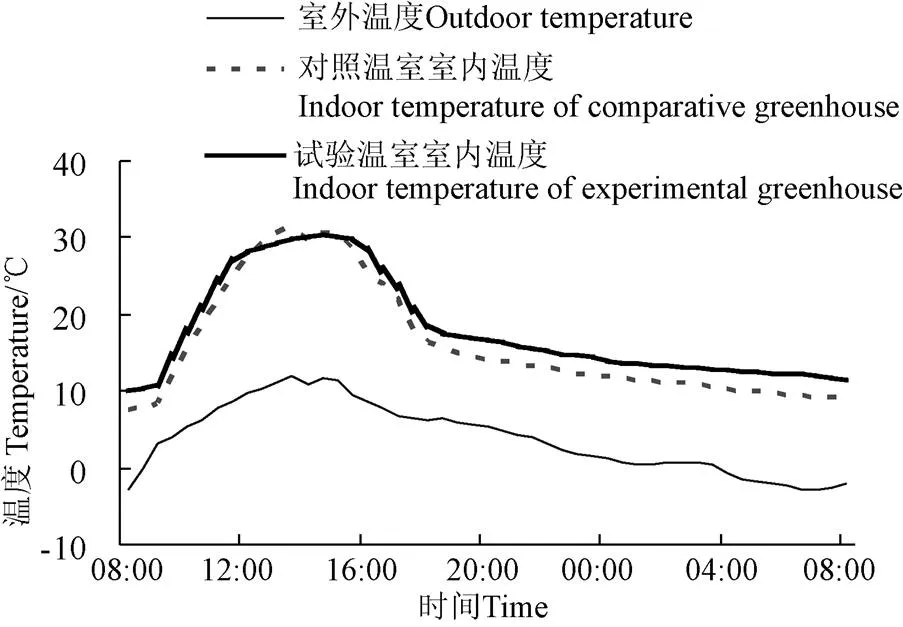
图7 多云室内外温度
2.2.5 试验温室与对照温室黄瓜生长状况对比
不同生育期的黄瓜植株株高、茎粗等生长指标见表3,果实产量见表4。
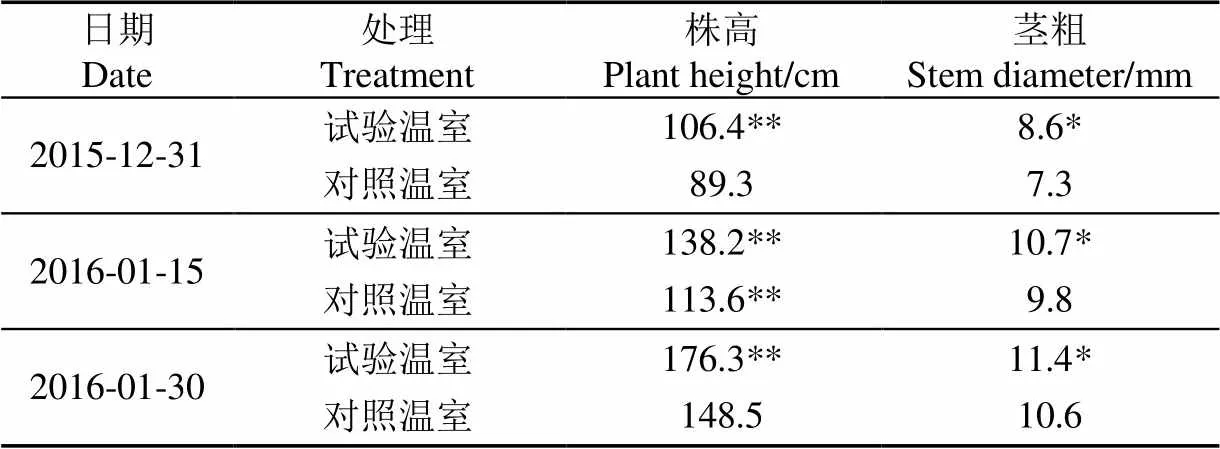
表3 不同生长期黄瓜植株株高及茎粗
注:用检验法进行差异显著性分析,**表示差异极显著(<0.01),*表示差异显著(<0.05),下同。
Note: The significant difference was analyzed by-test, ** indicated extremely significant differences (<0.01), and * indicated significant difference (<0.05), the same as below.
由表3可以看出,在不同的生长期内,试验温室内的黄瓜植株的株高、茎粗等主要生长形态指标均高于对照温室内的黄瓜植株。其中,生长旺盛的开花期(2015年12月31日),试验温室的黄瓜植株高度比对照温室的平均高17.1 cm,茎粗比对照温室的平均粗1.3 mm;坐果期(2016年1月15日),两温室的植株高度相差24.6 cm,茎粗相差0.9 mm;2016年1月30日,试验温室的黄瓜植株高度比对照温室的高27.8 cm,茎粗比对照温室的粗0.8 mm。在相同的栽培管理条件下,由于试验温室较好的调温效果,使得植株生长较对照温室明显加快,试验温室内的黄瓜生长状况明显优于对照温室的黄瓜生长。

表4 两温室内黄瓜情况(2016-02-20)
由表4可知,试验温室和对照温室内黄瓜的单果平均质量分别为217和159 g,试验温室内黄瓜的单果平均质量为对照温室的1.4倍,试验温室和对照温室内黄瓜的结果数分别为5.6个和4.3个,试验温室内黄瓜的单株结果数为对照温室的1.3倍,试验温室和对照温室内黄瓜的单株产量分别为1 215.2和683.7 g,试验温室内黄瓜的单株产量为对照温室的1.8倍,说明试验温室内的结果情况明显优于对照温室,试验温室内的热环境更适于黄瓜的生长。
3 结论与讨论
通过对比试验,分析了石膏基石蜡/膨胀珍珠岩复合相变储能保温砂浆保温性和蓄、放热性能。结果表明:
1)复合相变储能砂浆的保温效果明显。在试验期内(2015年12月10日—2016年2月18日),保温砂浆温室的日最低温度比对照温室平均高出1.5 ℃。在多云和晴天的夜间,试验温室室内温度比对照温室室内温度分别平均高2.3、2.7 ℃。即使在阴天,也能使砂浆温室平均室温高于对照温室1.6 ℃左右;
2)复合相变储能砂浆蓄、放热效果较好,有效缩小昼夜温差。在多云和晴天,复合相变储能保温砂浆使温室昼夜温差分别降低了3.5和3.1 ℃。白天,多云和晴天的砂浆温室也将温度分别降低了1.2和1.3 ℃。因此,新型材料有效减弱了温室内的温度波动,起到了“削峰填谷”的作用;
3)在相同栽培管理条件下,利用保温砂浆加厚砖墙的日光温室内,种植同龄期黄瓜的株高、茎粗和产量均优于未改造的温室,表明保温砂浆在保温性和蓄、放热性能方面优势明显,更有利于作物生长。
复合相变储能保温砂浆将在不同墙体日光温室中进行应用试验研究,以期与其他砌块墙体日光温室进行组合取得良好的保温、蓄放热效果;试验温室面积较小,复合相变储能保温砂浆将在大跨度日光温室中使用,并监测其应用效果;对于雾霾、雨雪等恶劣天气情况下,复合相变储能保温砂浆的蓄热保温效果将做进一步研究。
[1] 韩云全,陈超,管勇,等. 复合相变蓄热墙体材料对日光温室热环境及番茄生长发育的影响[J]. 中国蔬菜,2012(18):99-105.
Han Yunquan, Chen Chao, Guan Yong, et al. Effect of composite phase change thermal storage wall materials on solar greenhouse thermal environment and tomato growth[J]. China Vegetables, 2012(18): 99-105. (in Chinese with English abstract)
[2] 马承伟,陆海,李睿,等. 日光温室墙体传热的一维差分模型与数值模拟[J]. 农业工程学报,2010,26(6):231-237.
Ma Chengwei, Lu Hai, Li Rui, et al. One-dimensional finite difference model and numerical simulation for heat transfer of wall in Chinese solar greenhouse[J]. Transactions of the Chinese Society of Agricultural Engineering (Transactions of the CSAE), 2010, 26(6): 231-237. (in Chinese with English abstract)
[3] 王晓冬,马彩雯,吴乐天,等. 日光温室墙体特性及性能优化研究[J]. 新疆农业科学,2009,46(5):1016-1021.
Wang Xiaodong, Ma Caiwen, Wu Letian, et al. Characteristic research and performance optimization of the solar greenhouse wall[J]. Xinjiang Agricultural Sciences, 2009, 46(5): 1016-1021. (in Chinese with English abstract)
[4] 马承伟,苗香雯. 农业生物环境工程[M]. 北京:中国农业出版社,2005.
[5] 马承伟,徐凡,赵淑梅,等. 日光温室热环境分析及设计方法研究[C]//第二届中国·寿光国际设施园艺高层学术论坛论文集. 北京:中国农业科学技术出版社,2011:70-79.
Ma Chengwei, Xu Fan, Zhao Shumei, et al. Solar greenhouse thermal environment analysis and design method research[C]// Proceedings of the Second China Shouguang International Horticulture Academic Forum. Beijing: China Agricultural Science and Technology Press, 2011: 70-79. (in Chinese with English abstract)
[6] 方慧,杨其长,张义. 基于热泵的日光温室浅层土壤水媒蓄放热装置实验[J]. 农业工程学报,2012,28(20):210-216.
Fang Hui, Yang Qichang, Zhang Yi. Experimental study on shallow soil assisted heat release-storage system with water-water heat pump in solar greenhouse[J]. Transactions of the Chinese Society of Agricultural Engineering (Transactions of the CSAE), 2012, 28(20): 210-216. (in Chinese with English abstract)
[7] 郭靖,邹志荣,刘玉凤. 不同方式封装的相变材料蓄热效果研究:基于日光温室[J]. 农机化研究,2012,34(2):137-140.
Guo Jing, Zou Zhirong, Liu Yufeng. Study on performance of heat preservation of phase change material packed in different ways: Based on solar greenhouse[J]. Journal of agricultural mechanization research, 2012, 34(2): 137-140. (in Chinese with English abstract)
[8] 陈超,果海凤,周玮. 相变墙体材料在温室大棚中的实验研究[J]. 太阳能学报,2009,30(3):287-293.
Chen Chao, Guo Haifeng, Zhou Wei. Experimental research of the composite phase change material in greenhouse[J]. ACTA Energiae Slaris Sinica, 2009, 30(3): 287-293. (in Chinese with English abstract)
[9] 薛亚宁,陈超,李清清,等. 复合相变蓄热墙体材料应用于日光温室的效果研究[J]. 北方园艺,2010(15):6-11.
Xue Yaning, Chen Chao, Li Qingqing, et al. Experimental results of the PCM wallboard material applied in the solar greenhouse[J]. Northern Horticulture, 2010(15): 6-11. (in Chinese with English abstract)
[10] 管勇,陈超,李琢,等. 相变蓄热墙体对日光温室热环境的改善[J]. 农业工程学报,2012,28(10):194-201.
Guan Yong, Chen Chao, Li Zhou, et al. Improving thermal environment in solar greenhouse with phase-change thermal storage wall[J]. Transactions of the Chinese Society of Agricultural Engineering (Transactions of the CSAE), 2012, 28(10): 194-201. (in Chinese with English abstract)
[11] Han Yunquan, Chen Chao, Guan Yong, et al. The thermal performance evaluation of the tri-layer structure wall with passive phase change heat storage in solar greenhouses[C]// APEC Conference on Low Carbon Town and Physical Energy Storage. Changsha, 2013: 602-607.
[12] Guan Yong, Chao Chen, Zhou Li, et al. Experimental study on effect of phase change energy storage wall materials on thermal performance of the solar greenhouse wall[C]// 7th International Symposium on Heating, Ventilation and Air Conditioning. Shanghai, 2011: 1410-1415.
[13] 陈超,李琢,管勇,等. 制作方式对日光温室相变蓄热材料热性能的影响[J]. 农业工程学报,2012,28(增刊1):186-191.
Chen Chao, Li Zhuo, Guan Yong, et al. Effects of building methods on thermal properties of phase change heat storage composite for solar greenhouse[J]. Transactions of the Chinese Society of Agricultural Engineering (Transactions of the CSAE), 2012, 28(Supp.1): 186-191. (in Chinese with English abstract)
[14] 王宏丽,李晓野,邹志荣. 相变蓄热砌块墙体在日光温室中的应用效果[J]. 农业工程学报,2011,27(5):253-257.
Wang Hongli, Li Xiaoye, Zou Zhirong. Application of brick wall with phase change rice husk in solar greenhouse[J]. Transactions of the Chinese Society of Agricultural Engineering (Transactions of the CSAE), 2011, 27(5): 253-257. (in Chinese with English abstract)
[15] 张勇,邹志荣,李建明,等. 日光温室相变空心砌块的制备及功效[J]. 农业工程学报,2010,26(2):263-267.
Zhang Yong, Zou Zhirong, Li Jianming, et al. Preparation of the small concrete hollow block with PCM and its efficacy in greenhouses[J]. Transactions of the Chinese Society of Agricultural Engineering (Transactions of the CSAE), 2010, 26(2): 263-267. (in Chinese with English abstract)
[16] 李凯,宋丹,王宏丽,等. 日光温室瓶胆式相变墙体热性能研究[J]. 北方园艺,2013(5):40-42.
Li Kai, Song Dan, Wang Hongli, et al. Thermal performance analysis of the cavity wall with PCM of solar greenhouse[J]. Northern Horticulture, 2013(5): 40-42. (in Chinese with English abstract)
[17] 孙心心,邹志荣,王宏丽,等. 新型复合相变墙日光温室性能实测分析[J]. 农机化研究,2010,32(3):168-170.
Sun Xinxin, Zou Zhirong, Wang Hongli, et al. Field measurement and analysis of performance of solar greenhouse with compound phase change material wall[J]. Journal of Agricultural Mechanization Research, 2010, 32(3): 168-170. (in Chinese with English abstract)
[18] 陈红武,李晓野,王宏丽. 日光温室用复合相变储热材料的实验研究[J]. 农机化研究,2009,51(7):192-194.
Chen Hongwu, Li Xiaoye, Wang Hongli. Experimental studies on compound phase change materials in greenhouses[J]. Journal of Agricultural Mechanization Research, 2009, 51(7): 192-194. (in Chinese with English abstract)
[19] 夏莉,张鹏,周圆,等. 石蜡与石蜡/膨胀石墨复合材料充/放热性能研究[J]. 太阳能学报,2010,31(5):610-614.
Xia Li, Zhang Peng, Zhou Yuan, et al. Study on the charging/discharging characteristics of paraffin and paraffin/ expanded graphite composite material[J]. ACTA Energiae Slaris Sinica, 2010, 31(5): 610-614. (in Chinese with English abstract)
[20] 李启金,姜葱葱,李国忠. 石蜡/膨胀珍珠岩复合相变储能材料的研究[J]. 砖瓦,2011(10):15-17.
Li Qijin, Jiang Congcong, Li Guozhong. Study on paraffin and expanded perlite composite phase change energy-storage materials[J]. Brick & Tile, 2011(10): 15-17. (in Chinese with English abstract)
[21] Bascetincelik A, Demirel, Y, Paksoy H O, et al. Greenhouse heating with solar energy stored by phase change material[C]// 15th National Agricultural Mechanisation Congress. September 20-22, Antalya, 1994: 698-705.
[22] 王蕊,姚轩,李珠. 玻化微珠相变保温蓄热材料在日光温室中的应用及其能耗分析[J]. 工程力学,2012,29(S2):216-220.
Wang Rui, Yao Xuan, Li Zhu. Application and energy consumption analysis of thermal insulation and heat storage phase change material with glazed hollow beads in greenhouse[J]. Engineering Mechanics, 2012, 29(S2): 216-220. (in Chinese with English abstract)
[23] 王朋,王宏丽,李凯. 硬脂酸正丁酯和石蜡复合相变储热材料的热性能测试[J]. 北方园艺,2009(11):132-135.
Wang Peng, Wang Hongli, Li Kai. Experimental studies on compound phase change material Composed of butyl stearate and paraffin used as heat storage in greenhouses[J]. Northern Horticulture, 2009(11): 132-135. (in Chinese with English abstract)
[24] 周玮. 相变蓄能墙体材料在日光温室节能应用中的可行性研究[D]. 北京:北京工业大学,2010.
Zhou Wei. Feasibility Study of Wall Material Phase Change Energy Storage Application in Greenhouse[D]. Beijing: Beijing University of Technology, 2010. (in Chinese with English abstract)
[25] 蒋晓曙,刘燕,李莽,等. 相变膨胀珍珠岩储能保温砂浆的性能研究[J]. 混凝土与水泥制品,2011(9):56-58.
Jiang Xiaoshu, Liu Yan, Li Mang, et al. Performance study on phase change energy storage expansion perlite thermal insulation mortar[J]. China Concrete and Cement Products, 2011(9): 56-58. (in Chinese with English abstract)
[26] 建筑砂浆基本性能试验方法标准:JGJ/T 70-2009[S]. 北京:中国建筑工业出版社,2009.
Standard of test method for basic performance of building mortar: JGJ/T 70-2009[S]. Beijing: China Building Industry Press, 2009. (in Chinese with English abstract)
[27] 李文波,薛锋,丁恩勇,等. 差示扫描量热仪对物质相变潜热的精确量度[J]. 分析测试学报,2006,25(2):16-19.
Li Wenbo, Xue Feng, Ding Enyong, et al. Accurate Determination of Latent Heat via Differential Scanning Calorimetry[J]. Journal of Instrumental Analysis, 2006, 25(2): 16-19. (in Chinese with English abstract)
[28] 绝热材料稳态热阻及有关特性的测定:GB/T 10294-2008[S]. 北京:中国标准出版社,2008.
Determination of steady state thermal resistance and related properties of thermal insulation materials: GB/T 10294-2008[S]. Beijing: China Standards Press, 2008. (in Chinese with English abstract)
[29] 周继华,安顺伟,王克武,等. 不同灌溉方式对大棚黄瓜生长、产量及水分生产效率的影响[J]. 作物杂志,2012(3):76-80.
Zhou Jihua, An Shunwei, Wang Kewu, et al. Effects of different irrigation methods on plastic house cucumber growth, yield and water use efficiency[J]. Crops, 2012(3): 76-80. (in Chinese with English abstract)
[30] 王宏丽,邹志荣,陈红武,等. 温室中应用相变储热技术研究进展[J]. 农业工程学报,2008,24(6):304-307.
Wang Hongli, Zou Zhirong, Chen Hongwu, et al. Research advances in technologies of phase-change heat storage and its application in greenhouses[J]. Transactions of the Chinese Society of Agricultural Engineering, 2008, 24(6): 304-307. (in Chinese with English abstract)
Application effect of composite phase change energy storage thermal insulation mortar in solar greenhouse
Zhou Ying1,2, Wang Shuangxi1※
(1.030801,; 2.274000,)
In order to improve the thermal environment of crop growth in solar greenhouse, a kind of gypsum-based paraffin/expanded perlite composite phase change energy storage thermal insulation mortar was studied in this paper. The composite phase change energy storage thermal insulation mortar was composed of complex shaped phase change particles, desulfurization gypsum, admixture and other components, and the reasonable formula and the production process of it were determined by experiments. The composite phase change energy storage thermal insulation mortar with reasonable formula had a suitable phase transition temperature of 25.6 ℃ and a higher phase change latent heat of 89.8 kJ/kg. The 50 mm composite phase change thermal insulation mortar was used in the back wall of the brick wall solar greenhouse as the experimental greenhouse. The original brick wall solar greenhouse without phase change material was used as the comparative greenhouse. The comparison test of these 2 greenhouses showed that: From December 10, 2015 to February 18, 2016, the minimum daily temperature of the experimental greenhouse was 1.5 ℃ higher than that of the comparative greenhouse on the average, and the difference reached 2.4 ℃ at the most. On overcast day, the heat preservation quilt was closed, and the indoor temperature of the experimental greenhouse was 1.6 ℃ higher than that of the comparative greenhouse. On sunny day, the indoor maximum temperature of the experimental greenhouse and the comparative greenhouse was 28.9 and 30.6 ℃, respectively, and there was 1.7 ℃ difference between the two greehouses. The indoor maximum temperature difference of the experimental greenhouse and the comparative greenhouse was 21.3 and 24.4 ℃, respectively, and the former was 3.1 ℃ lower than the latter. During the night (from 17:00 to 08:00 in the next day), the average indoor temperature of the experimental greenhouse was 2.7 ℃ higher than that of the comparative greenhouse. On cloudy day, the indoor maximum temperature of the experimental greenhouse was 1.4 ℃ lower than that of the comparative greenhouse; the indoor maximum temperature difference of the experimental greenhouse and the comparative greenhouse was 20.4 and 23.9 ℃, respectively, and the former was 3.5 ℃ lower than the latter. During the night (from 17:00 to 8:00 in the next day), the average indoor temperature of the experimental greenhouse was 2.3 ℃ higher than that of the comparative greenhouse. Under the same cultivation and management conditions, in the vigorous growth period and fruit-bearing stage, the height of cucumber plants in the experimental greenhouse was 17.1 and 24.6 cm higher than that of the comparative greenhouse. The single-fruit quality of the cucumber in the experimental greenhouse was 1.4 times that of the comparative greenhouse, the number of fruits per plant in the experimental greenhouse was 1.3 times that of the comparative greenhouse, and the output of per plant in the experimental greenhouse was 1.8 times that of the comparative greenhouse. The test results show that, the composite phase change energy storage thermal insulation mortar has a good heat preservation and storage and release effect, and has an obvious improvement effect on the thermal environment in solar greenhouse. The thermal environment in the experimental greenhouse is more suitable for the growth of cucumber.
phase change material; temperature; heat preservation; thermal insulation mortar; solar greenhouse; thermal environment
10.11975/j.issn.1002-6819.2017.20.024
S625
A
1002-6819(2017)-20-0190-07
2017-06-27
2017-09-22
山西省煤基重点科技攻关项目(FT2014-02);山西省科技攻关项目(20130311010-4);菏泽学院基金项目(XY14KJ09)
周 莹,女,山东济宁人,助教,博士生,主要从事设施农业工程与技术的研究。Email:zhouying.yy@163.com
※通信作者:王双喜,男,山西翼城人,教授,博士生导师,主要从事农业生物环境与能源工程的研究,Email:sxauwsx@126.com
中国农业工程学会会员:周莹(E041500034M)
周 莹,王双喜. 复合相变储能保温砂浆在日光温室中的应用效果[J]. 农业工程学报,2017,33(20):190-196. doi:10.11975/j.issn.1002-6819.2017.20.024 http://www.tcsae.org
Zhou Ying, Wang Shuangxi. Application effect of composite phase change energy storage thermal insulation mortar in solar greenhouse[J]. Transactions of the Chinese Society of Agricultural Engineering (Transactions of the CSAE), 2017, 33(20): 190-196. (in Chinese with English abstract) doi:10.11975/j.issn.1002-6819.2017.20.024 http://www.tcsae.org

